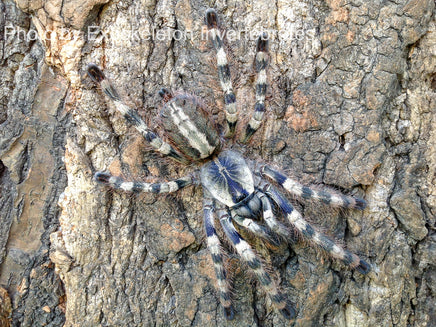
Meet the Poecilotheria formosa, a true spectacle in the tarantula world. This arboreal species, commonly known as the Salem Ornamental, is known for its striking appearance and elusive nature. With its vibrant patterns and swift movements, the Salem Ornamental is a mesmerizing addition to any collection, captivating both seasoned hobbyists and newcomers alike.
Care Details:
- Temperature: Ideal range for the Poecilotheria formosa is 75 to 85°F (24 to 29°C). These conditions encourage active feeding, rapid growth, and regular molting.
- Humidity: Maintain humidity at around 60-70%. Water dishes are not necessary, but if used, they pose no harm. I personally do not use them.
- Housing: As an arboreal species, the housing needs of Poecilotheria formosa vary with size. For babies, a small vial up to 5 inches tall and 2 inches in diameter with ample ventilation is suitable. Free vials are available at checkout—just remember to request one. Juveniles thrive in a 7-8 inch tall enclosure, while adults require 12 to 16 inches to accommodate their climbing behavior.
Diet: This species thrives on a varied diet of crickets and cockroaches, including Dubia, Red-runner, Lobster, and Madagascar hissing roaches. For the younger ones, baby crickets and baby roaches are ideal. If a smaller prey item is needed, simply crush its head and leave it in the enclosure; the tarantula will handle the rest. Always remember to remove uneaten food to prevent mold growth. Occasionally, a pinky or hopper mouse can be offered as a treat, but this should be only occasional to avoid health issues from too much calcium.
In-depth Facts:
- Latin name: Poecilotheria formosa
- Common name: Salem Ornamental
- Locale: Originating from the forests of Salem, India.
- Category: Arboreal, extensive webber.
- Size: Females can grow up to 7 inches, while males typically reach about 6 inches.
- Urticating hairs: No
- Growth rate: Fast
- Life span: Females can live up to 12 years, while males may live around 3-4 years.
- Recommended levels: Suitable for keepers with a bit of experience due to their speed and moderate venom potency.
Stay Connected:
- Instagram: Follow my Instagram, I'm most active here.
- YouTube: For care and education videos, check out my YouTube channel.
- Facebook: Over here I have all my reviews.
- TikTok: Visit my TikTok for additional content.
Safety Disclaimer: Experiencing a tarantula bite is an extremely rare occurrence, and it's important to note that there have been no recorded fatalities due to a tarantula bite. The venom potency varies across species, with Old World tarantulas generally having stronger venom than their New World counterparts. Within the Old World category, the Poecilotheria genus is known for having particularly potent venom.
It's crucial to approach tarantulas with respect and understanding. If you happen to get bitten, which is unlikely, the key is to stay calm. In most cases, the discomfort is superficial and subsides within a few minutes to a few hours. However, bites from species with more potent venom may result in symptoms lasting up to a week. Remember, larger tarantulas tend to have more venom than smaller ones.
Please be aware that I cannot assume responsibility for bites. Tarantula handling should be done at your own risk. In my 11 years of experience with these creatures, I have only been bitten once, by a species with highly potent venom. While the experience was painful, the symptoms had completely disappeared after a week.
Handle tarantulas responsibly, and always prioritize your safety and the well-being of the tarantula.